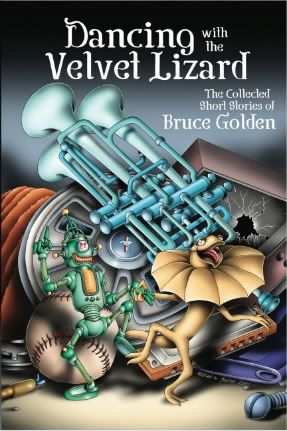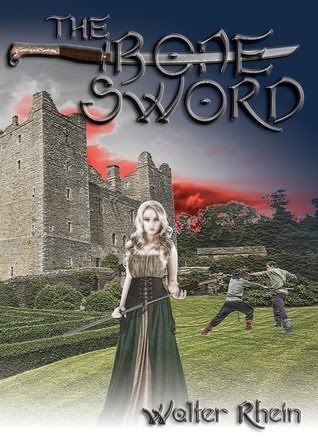Dancing with the Velvet Lizard by Bruce Golden
Reviewed by Carolyn Crow

Bruce Golden
Dancing with the Velvet Lizard
Zumaya Otherworlds
2011
389 pgs
ISBN 978-1-934841-26-6
$15.99
One thing you can say about Bruce Golden's fiction, is that it always delivers something different. From such diverse novels as Evergreen and Better Than Chocolate to his short stories, you'll likely find something innovative and entertaining. No extended series or sequels, just new characters, new conflicts, and sometimes, new laughs. He's one of the best kept secrets in the world of speculative fiction.
Dancing with the Velvet Lizard, his first-ever collection of short fiction, includes a mind-bending 33 tales, with a fine balance of science fiction, fantasy, horror, and humor--more than one something for everyone. It's certainly the largest collection of such yarns I've ever come across.
There's no single theme to this collection. From the positively terrifying 'The Withering,' to the tongue-radiating-in-cheek 'I Was a Teenage Hideous Sun Demon,' to the chilling apocalyptic tale of 'Holiday,' Golden’s work runs the gamut from dark to laugh-out-loud funny. No two stories are alike, and it's this variety that makes it well worth the reader's time. No one's going like every story in a collection of short fiction (a handful of these tales were just so-so to me), but I challenge you not find enough here to make it worthwhile--no matter what you paid for it.
Along the way, Golden explores the personal consequences of popping pills for better orgasms, and provides a "what if" to what might have really happened to America’s beloved bandleader Glenn Miller during World War II. He visits a Native American shaman who sends the government a bill for making it rain, and a 119-year-man who drives his classic automobile into the middle of an insurrection, chased by flying cars. He asks if Little Red Riding Hood really lived happily ever after, and whether beauty is still in the eye of the beholder when that eye sees through an alien lens.
Dancing with the Velvet Lizard starts with one of the most powerful stories in the book. A tale that looks (not so far) into the future, when we begin to warehouse our elderly, and care for them with machines. This one made me cry.
Forget about steroids, in his story 'One of Nine,' Golden looks into a future where baseball players are grown in tanks, but don't have all the rights of "regular" humans. This tale has the same civil rights overtones as his novel Mortals All.
In the not-too-distant future of 'Profile of a Patriot,' a good American is someone who’s careful about what he says, doesn’t question authority, and is always ready to bear witness against his neighbor. He switches gears again for 'The Apocryphist,' to divulge how the art of story-telling began on one particularly feline alien world.
In his Firebrand Fiction award-winning story 'I Found Love on Channel 3,' Golden delivers a portrait of man who lusts after a sexy cartoon character, who then comes alive and makes his fantasy come true--or does she? Sex is also a dangerous element in another tale, where a young couple's orgasms are wreaking havoc with the fabric of time.
Admittedly, there are few happy endings herein, but if you like stories that make you think, that draw you in so you're rooting for the protagonist, so that you care, you won't be dissatisfied. However, just when you think you'll be enveloped by the darkness, the collection shifts gears, going from heartbreaking to hilarity. Golden revisits Dave and his computer friend Hal, but adds a Cheech & Chong twist; lets a late '50s B-movie monster relate his life story; sends an angelic censor to the game show from Hell; and shows us a seldom seen side of God, when the deity grabs a scribe from his heavenly ranks to write his biography.
Golden's greatest strengths have always been his ability to create vivid characters and craft uncannily true-to-life dialogue. As a result, his narratives are extremely character-driven and fast-moving. If you like to dwell in the land of purple prose and endless descriptive paragraphs, this book isn't for you. Golden doesn't spend much time on that. Instead he drops you into the middle of scene where things are already happening.
After each tale Golden includes a little epilogue that I found very interesting. He reveals something about the story’s background, what inspired it, how it was written, places it was published (though some of the tales in this collection are being published for the first time). I found these tidbits fascinating because they also reveal a great deal about the author himself--his passions, his politics, his foibles.
If you dare to dance with The Velvet Lizard, you won't be disappointed.
The Bone Sword by Walter Rhein
Reviewed by M. Arkenberg

I'm ashamed to admit that I approached this novel with some trepidation. My recent experiences with book-length heroic fantasy had led me not to expect much in the way of characterization, plotting, or prose style. But not only did Rhein's novel vastly exceed my expectations, it's one of the very best I've read in the genre.
The Bone Sword opens with Malik, a mysteriously skilled warrior who is soon revealed to be a deserter from the elite Camden Guard, stumbling feverishly into an inn. Here, Malik clashes with the first of the novel's deftly-written, thoroughly despicable villains: Bertrand, a drunken and predatory cousin of the Earl of Miscony. Malik kills Bertrand and finds himself running from the Earl's vicious hounds—straight into the arms of the far more vicious Father Ivory. This chase scenes is hugely enjoyable, both for its intimate look at Malik's thought process---believable, well-reasoned, sometimes dryly witty, sometimes heartbreakingly damaged—and Rhein's excellent action-scene prose. While Rhein's descriptive prose sometimes contains a questionable adjective, his battle scenes are flawlessly written. He expertly manipulates paragraph lengths and repeated sentences to echo the furious pace of the action and draw the reader into the scene.
Meanwhile, a young peasant woman named Jasmine and her twin brother Noah sit at their dying father's bedside. Despite the danger from Father Ivory, the unnerving priest who condemns all magic as evil, Jasmine uses her power of healing to save her father's life. This innocent act has dramatic repercussions; Father Ivory declares that the twins' father has compromised his soul, burns the twins' house with their father inside (!), and arrests Jasmine and Noah for a more formal execution at the Earl of Miscony's palace. There, Noah and Jasmine meet another of the Earl's prisoners—Malik, who leads them through an escape right before the Earl and Father Ivory's eyes.
As their enemies search for them with increasingly horrifying methods, Jasmine's healing powers inspire the people of Miscony. Malik, Jasmine and Noah find themselves at the center of a revolution against the Earl, Father Ivory, and the deadly Nightshade warriors. Rhein does a fantastic job portraying the emotional struggle for Jasmine, the healer forced to inspire killing, and Malik's own struggle with his tortured past among the Camden Guard. Through all the conflict, both physical and emotional, Rhein continually raises the stakes for the heroes, introducing new responsibilities and increasingly dangerous villains—including Malik's old master, the cruel and capable Oberon Keels. I don't want to spoil the ending, so I'll only say that it was suspenseful enough to keep me up reading well into the small hours of the morning!
If you enjoy deftly-written action, creepy villains, and believable and inspiring heroes, I cannot recommend The Bone Sword highly enough. Once you've read it, I'm sure you'll join me in anxiously awaiting whatever Walter Rhein comes out with next!
The Bone Sword may be purchased from Amazon.com, Rhemalda publishing, or a bookstore near you.
Iara by Caroline Sloan
Reviewed by M. Arkenberg

Caroline Sloan's debut novel gives the impression of having been imagined more carefully than it was written. In Iara, Sloan creates an elaborate mythology that identifies the predator-goddess Iara in numerous and widely-separated cultures: as Sedna among the Inuit, Mishibizhiw among the Algonquin, a queen of the Amazons in Scythia, and Iara herself among the Yanomamo in Brazil. Now this strange goddess has become incarnated as a human, a New Zealand legal executive named Mara, whose only indication that she is anything supernormal is a series of disturbing dreams about predatory animals.
Then something truly bizarre occurs; Mara falls overboard while whale watching and wakes up on the island of Tasmania, hundreds of miles away. To recover from this strange experience, she goes to say with friends in Canada, but changes her plans at the last moment and winds up living near an Algonquin reservation. There, she meets an Algonquin man named Jesse, and falls deeply in love with him—despite the boyfriend, Sebastain, she has left waiting for her in New Zealand. As her love for Jesse deepens, Mara discovers a number of hidden powers, including the ability to transform into a dragon and a mermaid. Jesse and Mara explore these powers alongside an Algonquin boy named Sam, until Sam is brutally murdered, and Mara framed for his death. Jesse and Mara then pursue a violent revenge on Sam's murderers, whose motives for framing Mara remain very murky.
If this plot summary sounds rushed and rather thin, it's because shares the main flaw of the novel; Iara is full of interesting details that don't quite come together to make a well-plotted story. The melodramatic romance ("she felt his lips caress her and she fainted" on page 57), Sam's strange fetishization of Mara's condition ("if only she would bite him—just for the thrill of being bitten" on page115), Mara and Jesse's spectacularly brutal (and afterwards unconsidered) murder of the person responsible for Sam's death, and many, many other incidents throughout the novel make for clearly imagined scenes, but they come off as distorted and unlikely on the page. Sloan clearly spent a good deal of time imagining Iara's incarnation in various cultures, but whatever research she may have done on Algonquin, Yanomamo, or Inuit beliefs never quite makes it onto the page, and the characters from these cultures veer dangerously close to the "Mystical Native Guide" stereotype. The description of the Navajo woman who inexplicably presented Mara with "ghost beads" before the events of the novel is especially egregious in this regard.
A misapplied attention to detail also manifests in Sloan's unusual reliance on brand names for descriptions. Mara never takes something out of her purse, she opens her "Jimmy Choo handbag." During an intimate scene with Jesse, she strips down to her "expensive Rigby and Peller bra."
Where Sloan does demonstrate skill as a plotter and a prose-stylist is in Mara's mysterious dreams of jaguars, polar bears, dragons and cougars, which are interspersed throughout the first half of the novel. These intriguing scenes help stretch a string of tension between the opening, when Mara has her unusual experience after whale-watching, and the middle, when Mara's relationship with Jesse deepens. These scenes also contain some of the loveliest prose in the novel, though even they are not exempt from some tension-disrupting details: a man standing in awe of a dragon's wings notes that they are exactly "350 metres" long (page 21).
Finally, the reasons behind Iara's incarnation as a young New Zealander remain unaddressed, unconsidered and unexplained.
If you enjoy a somewhat idealized romance, a powerful (rather than deftly-characterized) female character, and a wide-reaching (rather than deep) reimagining of mythology and folklore, there are worse guilty pleasures than Iara. As for me, I applaud the attempt and the thought that clearly went into it, but I believe this novel could have benefited from another draft and a generous application of editorial red ink.
Iara may be purchased from Amazon.com, Troubador publishing, or a bookstore near you.
Carolyn Crow works as an editor for Damnation Books/Eternal Press and writes book reviews. Her recent editing projects include Ultimate Duty, An Ocean Apart, Intricate Entanglement, and Elysium.
M. Arkenberg is the editor of Mirror Dance and its sister publication, the historical fiction e-zine Lacuna. Her short fiction and poetry have appeared in Strange Horizons, Ideomancer, Fantasy Magazine, Clarkesworld, and dozens of other places.





0 comments:
Post a Comment